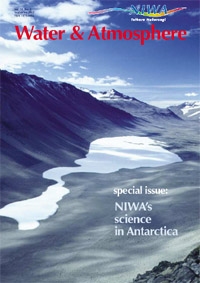
The New Zealand Ministry of Fisheries has a significant research interest in the Southern Ocean, and particularly in the Ross Sea region of Antarctica. The Ministry’s activities are directed towards protecting the health of the aquatic environment and enabling New Zealanders to get the best value from the sustainable and efficient use of fisheries. Two themes are covered: Fisheries and Biodiversity.
Antarctic fisheries
There is still much to learn about New Zealand’s Antarctic fisheries, on scientific, economic, social and cultural fronts. However, probably the most essential information needed at this stage relates to the status of the fish stocks. Research efforts are therefore focussed on obtaining biological information, fisheries catch and effort statistics, and the development of techniques for estimating biomass and sustainable yield (for example, tag recapture of toothfish). The same research also contributes significantly to meeting our international obligations to the management of Antarctic fisheries through the Convention for the Conservation of Antarctic Marine Living Resources (CCAMLR). There have already been notable research successes as a result of co-operation between MFish, NIWA and the Fishing Industry. These include the validation of age and growth of Antarctic toothfish, and genetic stock discrimination for Patagonian toothfish.
The Ministry’s Antarctic fisheries research has four key research topics:
- target species (Antarctic toothfish, Patagonian toothfish);
- non-target fish species (rattails, skates);
- non-target non-fish species (seabirds, marine mammals);
- ecological systems.
More information can be obtained from the convenor of the Antarctic Fisheries Stock Assessment Working Group, Neville Smith ([email protected]).
Marine biodiversity
The Ministry of Fisheries' BioRoss research programme aims to improve our understanding of the marine biodiversity of the Ross Sea region. It also aims to contribute to the development of a network of marine protected areas in the Ross Sea region. BioRoss contributes to the goals and objectives of the New Zealand Biodiversity Strategy, and to New Zealand’s international obligations under the Convention on Biological Diversity (CBD), the Antarctic Treaty, and CCAMLR.
The objectives of BioRoss are to continue to develop the inventory of the biodiversity of marine communities in the Ross Sea region and to facilitate better state-of-the-environment reporting. To do this, the Ministry has commissioned directed research on the diversity of selected marine communities, both benthic and planktonic. More details may be found at www.biodiversity.govt.nz. The BioRoss programme has already provided a comprehensive review of existing information on the marine biodiversity of the Ross Sea region, and where the major gaps are. Other progress is outlined in “Assessing biodiversity on the Antarctic sea floor”. The planned Tangaroa and Italica voyages in January 2004 will provide the largest single injection of information for many years.
Jacqui Burgess Science Manager, Biodiversity Ministry of Fisheries
